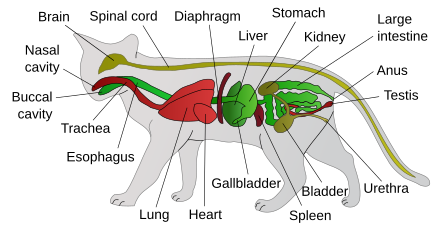Feline lower urinary tract disease (FLUTD) is a generic category term to describe any disorder affecting the bladder or urethra of cats.[1]

It encompasses around 10 different diseases of the lower urinary tract, all of which can present with very similar symptoms:[2]
- frequent urination (polyuria)
- blood in urine (hematuria)
- painful, frequent urination of small volumes that are expelled slowly only by straining (stranguria)
- difficult or painful urination (dysuria)
- urinating in "inappropriate" places or house-soiling (periurea)
Some of these symptoms may be the result of a form of FLUTD which could result in a blockage of the male urethra (e.g. obstructive feline idiopathic cystitis). However the same symptoms can also present for a non-obstructive form of FLUTD. Therefore, a careful differential diagnosis needs to be undertaken to distinguish between an obstructive case (which is an emergency) and a non-obstructive case (which is not) given that the symptoms are very similar for both. The vast majority of FLUTD cases are non-obstructive, regardless of underlying cause.
FLUTD is common in adult cats, affecting from 0.5% to 1% of the population. It affects cats of both sexes. Males are more prone to problems related to obstructions due to their long, narrow urethra. Urinary tract disorders have a high rate of recurrence, and some cats seem to be more susceptible to urinary problems than others.
An older term, feline urologic syndrome (FUS) is obsolete. It was renamed to discourage the perception that the clinical signs seen represent one disease with one cause.[3]
- ^ Forrester, S. (Oct 2015). "FLUTD: How Important is It?". ResearchGate. Retrieved 2019-03-14.
- ^ Dowers, Kristy (Oct 2008). "Working up FLUTD (Proceedings)".[permanent dead link]
- ^ "Feline lower urinary tract disease". Archived from the original on 2012-03-15. Retrieved March 3, 2012.